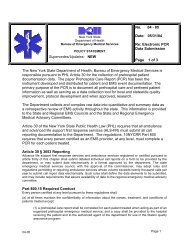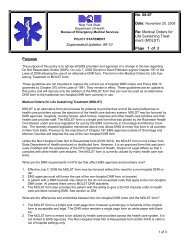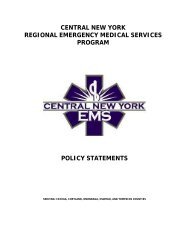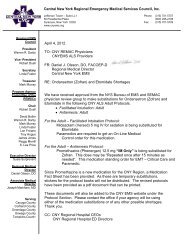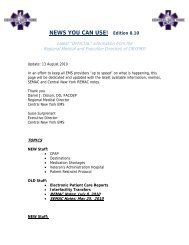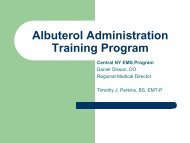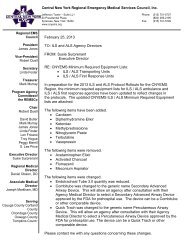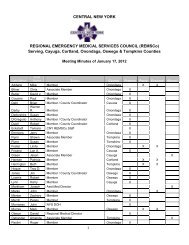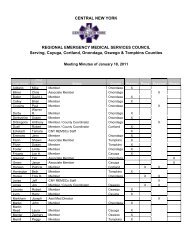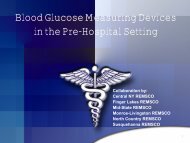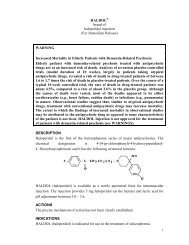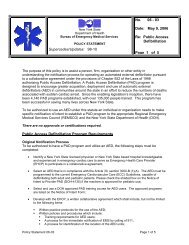Synthetic Cathinones (Bath Salts): An Emerging Domestic Threat
Synthetic Cathinones (Bath Salts): An Emerging Domestic Threat
Synthetic Cathinones (Bath Salts): An Emerging Domestic Threat
You also want an ePaper? Increase the reach of your titles
YUMPU automatically turns print PDFs into web optimized ePapers that Google loves.
Product Number 2011-S0787-004National Drug Intelligence Center“bath salt”-related calls had occurred in 2010—85 from Louisiana alone. Effects reported to thecenters included increased blood pressure, increased heart rate, agitation, hallucinations, extremeparanoia, and delusions; no deaths were reported. 21 The Louisiana Department of Health andHospitals also issued a warning regarding synthetic cathinones (bath salts), mentioning severalsymptoms experienced by hospitalized patients in addition to those mentioned above, includingchest pain, headache, and suicidal thoughts. 22 From January 1 through May 12, 2011, the AAPCCreceived 2,237 “bath salt”-related calls from poison control centers in 47 states and the Districtof Columbia—a significant increase from the 302 calls recorded for all of 2010. 23 (See Table 1.)Table 1. “<strong>Bath</strong>-Salt”-Related Calls Reported toU.S. Poison Control CentersYearNumber of Calls2009 02010 3022011* 2,237Source: American Association of Poison Control Centers, data run by AAPCC onMay 12, 2011.*Data reflect calls received and reported from January 1, 2011, through May 12, 2011.<strong>Synthetic</strong> cathinones are used by a geographically and demographically diverse abuserpopulation. No current U.S. population, household, or user survey contains questions regardingsynthetic cathinones or synthetic cathinone products, but some indicators suggest the demandfor and use of synthetic cathinone products are widespread. The AAPCC has issued multiple“bath salt abuse” press releases since December 2010, state health departments are posting “bathsalt” warnings on their web sites, 24 and state e, 25 and local f governments are introducing legislationand ordinances to reduce the availability of synthetic cathinones in their areas. 26 In addition,DEA National Forensic Information System (NFLIS) is receiving increasing reports of syntheticcathinone seizures. In 2009, NFLIS received 14 reports of analyzed seizures related to syntheticcathinones from 8 states; however, in 2010, NFLIS received 290 reports of analyzed seizuresfrom 21 states. 27 The AAPCC reports that “bath salts” abuse patients seeking medical attentionrange from teenagers to those in their 40s. 28 Moreover, synthetic cathinone abusers likely areindividuals who seek stimulant effects similar to those produced by cocaine, amphetamine/methamphetamine(illicit and prescription), and MDMA. 29<strong>Synthetic</strong> cathinones abusers likely are attracted to the drugs because they can evademost drug testing. Most current routine drug testing screens do not detect the presence ofsynthetic cathinones. Consequently, the drugs may appeal to some abusers who are subject tomandatory drug testing. While synthetic cathinones are not detected by routine screens, g, 30 somecommercial drug testing laboratories are beginning to offer specialized synthetic cathinonee. As of May 4, 2011, according to the National Conference of State Legislatures, a total of 15 states had taken actionto ban at least one of the chemicals used in drugs labeled as “bath salts,” either through legislative or administrativeaction; and 31 state legislatures have introduced legislation to restrict these substances.f. Contact your county government for local “bath salt” ordinances.g. Most drug testing companies offer an expanded test that includes a few additional drugs in the testing process. Typicallythe tests will look for a few of the following: ethanol (alcohol), hydrocodone (Lortab, Vicodin), barbiturates,methaqualone (Quaaludes), methadone, benzodiazepines (e.g., Valium), MDMA (ecstasy), propoxyphene (Darvon).5



